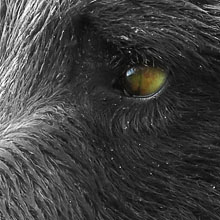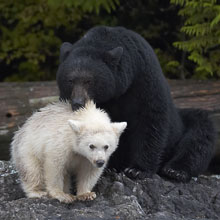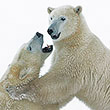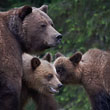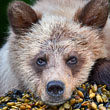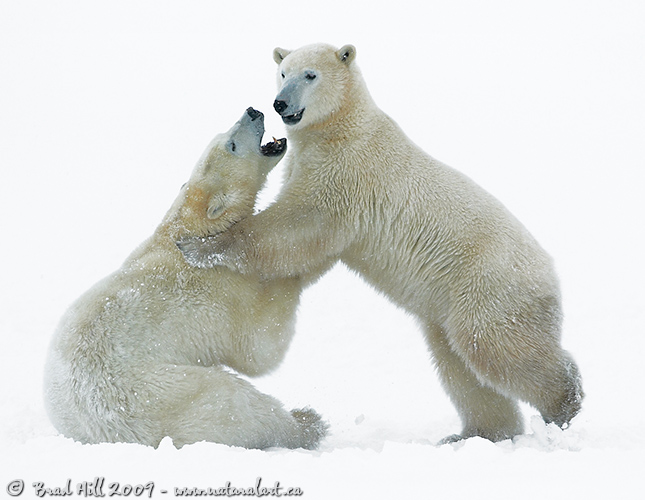
In the Field
Polar Polka. Cape Churchill, MB, Canada. October 24, 2004.
Watching an extended Polar Bear sparring session in a natural setting is an amazing experience. Once you get past the sheer physical and emotional power of the spectacle you start seeing the little things - like the geometric shapes formed by the bears and, for fleeting moments, the almost human-like postures and mannerisms the bears exhibit. These two bears had been sparring for at least 20 minutes when, for just an instant, the bear on the right seemed to start dancing! Fortunately I was shooting almost continuously (thank Photeus for large-capacity memory cards!) and I successfully captured the moment in time.
Behind the Camera
Polar Polka. Cape Churchill, MB, Canada. October 24, 2004.
Digital Capture; Compressed RAW (NEF) format; ISO 200.
Nikon D2H with Nikon 200-400 mm f/4G ED-IF AF-S VR lens @ 360 mm (540 mm equivalent with digital conversion factor) supported on bean bag.
1/500s @ f5; +1 exposure compensation from matrix-metered exposure setting.
At the Computer
Polar Polka. Cape Churchill, MB, Canada. October 24, 2004.
RAW Conversion to 16-bit TIFF, including first-pass sharpening, using Phase One's C1 Pro.
All further digital correction using Adobe's Photoshop CS, including selective mid-tone contrast adjustment (using Photoshop's Shadow/Highlight tool), selective saturation enhancement, and selective sharpening for web output.
Conservation
Polar Polka. Cape Churchill, MB, Canada. October 24, 2004.
Ten percent of the revenue generated by this image will be donated to the Yellowstone to Yukon Conservation Initiative.
Species Status in Canada*: Special Concern (November 2002).
Polar Bears (Ursus maritimus) are the largest terrestrial carnivores on the planet and the most carnivorous of all bears. They are highly specialized and feed almost exclusively on Ringed Seals. Polar Bears hunt their prey from ice sheets and are dependent upon these ice sheets for their survival.
Like any highly-specialized organism, Polar Bears are highly susceptible to habitat alteration. Climate change - natural or human-induced - is probably the greatest long-term threat to Polar Bear survival. The longer ice-free seasons experienced in the southern reaches of their distribution is already making it difficult for them to hunt.
The Yellowstone to Yukon (Y2Y) Conservation Initiative seeks to ensure that the world-renowned wilderness, wildlife, native plants, and natural processes of the Yellowstone to Yukon region continue to function as an interconnected web of life, capable of supporting all of its natural and human communities, for current and future generations.
For more information on the status of Polar Bears in Canada, go to: http://www.speciesatrisk.gc.ca and search under "Polar Bears".
*as determined by COSEWIC: The Committee on the Status of Endangered Wildlife in Canada


















